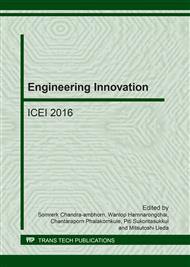p.246
p.252
p.258
p.264
p.271
p.277
p.283
p.289
p.295
Productions and Properties of Bacterial Cellulose from Oil Palm Shoot Juices Felled Medium and Coconut Medium
Abstract:
Bacterial Cellulose (BC) was produced by Acetobacter xylinum TISTR 086 use mixing of oil palm shoot juices (OPSJ) and coconut juice (CJ) medium with or without nutrient supplemented or OPSJ was digested with α-amylase. Results showed the highest yield was obtained at OPSJ with CJ at mixing ratios of 50% (4.70±0.11 g/L) and the lowest yield was obtained at OPSJ with CJ at mixing ratios of 0% (3.54±0.11 g/L). OPSJ was digested with 1300 lU/gm at concentration enzyme 650 IU/L at 37 °C for 24 h has highest sugar concentration of 73.93±0.12 g/L. Amylase digested OPSJ mixed with coconut juice’s highest bacterial cellulose production at OPSJ with CJ at mixing ratios of 50% (4.94±0.13 g/L), respectively. Moreover, the BC obtained had molecular weight from 332,122 to 503,233 g/mol. The chemical structure of BC produced was studied using Fourier Transform Infrared Spectroscopy (FT-IR) and X-ray defections. The morphology of BC was investigated by Scanning Electron Microscopy (SEM). Thermal property was further studied using Differential Scanning Calorimetry (DSC) and Thermogravimetic Analysis (TGA). This study obviously showed the ability of OPSJ, a suitable and cheap carbon source, to be used as a substrate in a fermentation medium for production of cellulose by Acetobacter xylinum TISTR 086.
Info:
Periodical:
Pages:
271-276
Citation:
Online since:
January 2017
Price:
Сopyright:
© 2017 Trans Tech Publications Ltd. All Rights Reserved
Share:
Citation:


